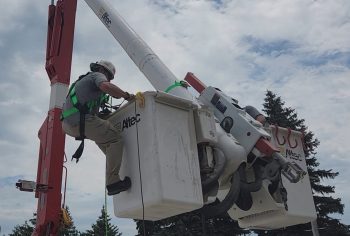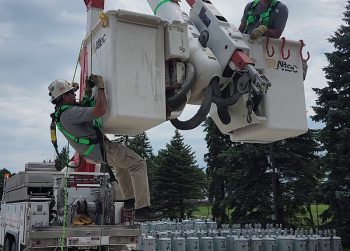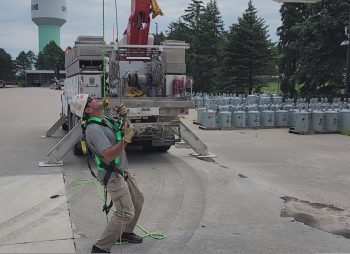A year in, self-rescue kits prove their worth to OPPD field workers

The truck boom failed at the worst possible time: at 3 a.m., on an empty highway, in the midst of the most destructive blizzard in OPPD history.
Tom Seeba tried not to panic. Minutes earlier, the boom’s bucket had carried the OPPD line technician up through subzero wind chills to repair damaged equipment on a power pole west of Union, Nebraska. A snow-filled, 50-mph wind stung his face. Even with gloves, his hands went numb.
Now, the bucket was stuck in place, 35 feet in the air. As two fellow line technicians on the ground scrambled to fix the problem, Seeba weighed his options: Should he jump down into a snow drift? Shimmy down the boom? Each choice seemed too dangerous, but help was probably an hour away.
‘Thankful to have it’
Then one of the line technicians remembered: Just a few months earlier, OPPD had taught them how to use self-rescue kits – a rope, straps, rappelling device and locking carabiner setup that lets solo field workers lower themselves safely from extended booms.
Minutes later, Seeba became one of the first OPPD field workers to use the emergency kit to save himself from extreme cold.
“It’s one of those things you hope you never have to use,” Seeba said. “You train on it, and you tell yourself you’re probably never going to use it. But in that moment, I was very thankful to have it.”
Last year, kits went out to workers based in the northern and southern rural areas of OPPD’s service territory, plus all troubleshooters, street-light workers and automation techs who work alone in bucket trucks. During major outages and storms, OPPD pairs solo workers with a partner for added safety.
Putting the kits to use
The kits have already proven their worth in the field, said Ray Knott, a supervisor at OPPD’s Louisville Service Center.
In December, an OPPD troubleshooter was responding to a service call in Omaha when the upper controls on his truck boom quit. The temperature was a frigid 22 degrees with a 10 mph wind. Just two days after he completed self-rescue training, the troubleshooter used it to safely abandon his bucket.

Other solo workers have encountered difficult situations. In January 2024, a journeyman line technician was operating in -45 degree windchills by Beaver Lake when his basket truck began to run roughly. The line technician managed to lower himself down inside the boom, just before it died.
“This is another situation that could have turned way worse if the truck had stalled sooner and he was still in the air,” Knott said.
Knott, who spent 26 years as a line technician, said he has seen trucks booms “gel up” and get stuck in midair during extreme weather. Hydraulic fires are a very rare but potential risk as well, as are grass fires ignited by super-hot truck mufflers. In most cases, OPPD workers can call a nearby mechanic or another crew to help.
“It’s just the nature of the business,” Knott said.
Looking ahead
Knott said he hopes to eventually offer the emergency kits to all OPPD field workers who use bucket trucks. Even though many in the Omaha metro are close to a service center and work in teams, Knott noted that they’re sometimes sent to rural areas during major storms.
“There isn’t always someone five or 10 minutes away,” he said. “It could be half an hour or an hour, and depending on the weather, that could be too long.”

Training with the emergency kits includes a safety briefing, a how-to video and firsthand practice at an OPPD service center.
Back on the highway work site, Seeba sat in his warm truck until feeling returned to his face and hands. Mechanics arrived a few hours later, after sunrise. They managed to lower the boom so they could get the truck back safely to a service center. Seeba continued his work restoring power to customers.
“It was smooth as can be,” he said.

Grant Schulte joined OPPD as a content generalist in 2022. He is a former reporter for The Associated Press, where he covered the Nebraska Legislature, state politics and other news for a global audience. He is a graduate of the University of Iowa and a proud Hawkeye. In his free time he enjoys running, reading, spending time with his wife, and all things aviation.
View all posts by Grant Schulte >







